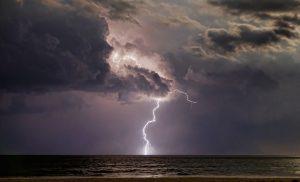 One of the quiet pleasures of a stay on the Outer Banks is a morning or evening stroll along the beach looking for interesting shells or sea glass, or whatever the flotsam of the sea brings to our shores.Sometimes—and it's pretty rare—there will be what appears to a hardened piece of sand...almost as though that hardened, rock-like sand has been fused by some great force. Which makes sense since that hardened piece of sand is probably fulgurite.Created by the superheated temperatures of lightning when it strikes the sand, fulgurite should be fairly common on the Outer Banks—we have lots of sand and thunderstorms are part of our summer weather.There may be more of it than we know, but finding it is only part of knowing how much there is, although even finding it is not all that easy. Shaded slightly darker than the surrounding sand, it blends in as though it was meant to be hidden. It is entirely possible to walk within inches of a piece fulgurite and not even know it is there.But what really makes this beautiful example of nature's work so rare is how fragile it is.To understand why fulgurite is so delicate, it's helpful to know what happens when it is created.When lightning strikes the sand, for one incredibly brief moment the air is superheated to 8000-30,000 degrees Celsius—actually hotter than the sun. The main ingredient in Outer Banks sand, silica, immediately melts and then fuses into a rock-like substance. As the heat is transferred beneath the surface the silica continues to melt and reform.Although the surface of the fulgurite is hardened, the extreme heat of the lightning is so great that it vaporizes the sand that comes in contact with the hottest point of the lightning, hollowing out the inside of the fulgurite. The melted sand that encases the vaporized core tends to be thin and very fragile.For anyone lucky enough to find a sample large enough to see inside, a world of wonder awaits.Sand—silica, actually—is the main ingredient in glass and the inside of fulgurite has a glass-like appearance, twinkling if light is shone on it. The shape is usually the shape of the lighting, although there are some exceptions to that.Typically what is seen is just the very tip of the fused sand, and attempts to excavate the rest of the sample very often result in the lightning shaped tendrils breaking into ever smaller pieces.Since thunderstorms occur everywhere in the world, different materials create different types of fulgurite and scientists have identified four types—sand, clay, caliche (calcium carbonate) and rock. The Outer Banks has no clay, rock or caliche—all of the fulgurite that is created here comes from the sand.There are differences though depending on where the lightning strikes.Fulgurite that is formed on the beaches will often have shells embedded in the walls. Although it does not always happen, if the strike is in wet or damp sand, instead of the sharp long shape of the lightning, the cooling effect of the water may create a more squat or rock-like appearance.The sand on Jockey's Ridge is finer and does not have the shell material found on the beach. As a consequence fulgurite found in the park, is more of the classic lightning bolt shape associated with the material and is often has a cleaner, smoother surface.Fulgurite can be turned into jewelry, although jewelers who have worked with it caution that it is so delicate that it is unsuitable for daily use. Although there are a couple of jewelers who have worked with fulgurite on the Outer Banks, Ginny Flowers at Cloud Nine in Nags Head is one of the most experienced.There are two places on the Outer Banks that have fulgurite collections. The collection that Jockey's Ridge State Park has is small, but highlights some excellent examples and gives a good sense of how fragile this material is.The largest collection—and it's pretty spectacular—it at the Outer Banks Beachcomber Museum on the Beach Road in Nags Head.The museum opens sporadically and on no clear schedule. However, information on their website indicates the next opening will be May 17. The fulgurite collection is just one of many reasons to visit this small but remarkable museum.The owners are in the process of moving the building, which is on the National Register of Historic Places, to a new location.
One of the quiet pleasures of a stay on the Outer Banks is a morning or evening stroll along the beach looking for interesting shells or sea glass, or whatever the flotsam of the sea brings to our shores.Sometimes—and it's pretty rare—there will be what appears to a hardened piece of sand...almost as though that hardened, rock-like sand has been fused by some great force. Which makes sense since that hardened piece of sand is probably fulgurite.Created by the superheated temperatures of lightning when it strikes the sand, fulgurite should be fairly common on the Outer Banks—we have lots of sand and thunderstorms are part of our summer weather.There may be more of it than we know, but finding it is only part of knowing how much there is, although even finding it is not all that easy. Shaded slightly darker than the surrounding sand, it blends in as though it was meant to be hidden. It is entirely possible to walk within inches of a piece fulgurite and not even know it is there.But what really makes this beautiful example of nature's work so rare is how fragile it is.To understand why fulgurite is so delicate, it's helpful to know what happens when it is created.When lightning strikes the sand, for one incredibly brief moment the air is superheated to 8000-30,000 degrees Celsius—actually hotter than the sun. The main ingredient in Outer Banks sand, silica, immediately melts and then fuses into a rock-like substance. As the heat is transferred beneath the surface the silica continues to melt and reform.Although the surface of the fulgurite is hardened, the extreme heat of the lightning is so great that it vaporizes the sand that comes in contact with the hottest point of the lightning, hollowing out the inside of the fulgurite. The melted sand that encases the vaporized core tends to be thin and very fragile.For anyone lucky enough to find a sample large enough to see inside, a world of wonder awaits.Sand—silica, actually—is the main ingredient in glass and the inside of fulgurite has a glass-like appearance, twinkling if light is shone on it. The shape is usually the shape of the lighting, although there are some exceptions to that.Typically what is seen is just the very tip of the fused sand, and attempts to excavate the rest of the sample very often result in the lightning shaped tendrils breaking into ever smaller pieces.Since thunderstorms occur everywhere in the world, different materials create different types of fulgurite and scientists have identified four types—sand, clay, caliche (calcium carbonate) and rock. The Outer Banks has no clay, rock or caliche—all of the fulgurite that is created here comes from the sand.There are differences though depending on where the lightning strikes.Fulgurite that is formed on the beaches will often have shells embedded in the walls. Although it does not always happen, if the strike is in wet or damp sand, instead of the sharp long shape of the lightning, the cooling effect of the water may create a more squat or rock-like appearance.The sand on Jockey's Ridge is finer and does not have the shell material found on the beach. As a consequence fulgurite found in the park, is more of the classic lightning bolt shape associated with the material and is often has a cleaner, smoother surface.Fulgurite can be turned into jewelry, although jewelers who have worked with it caution that it is so delicate that it is unsuitable for daily use. Although there are a couple of jewelers who have worked with fulgurite on the Outer Banks, Ginny Flowers at Cloud Nine in Nags Head is one of the most experienced.There are two places on the Outer Banks that have fulgurite collections. The collection that Jockey's Ridge State Park has is small, but highlights some excellent examples and gives a good sense of how fragile this material is.The largest collection—and it's pretty spectacular—it at the Outer Banks Beachcomber Museum on the Beach Road in Nags Head.The museum opens sporadically and on no clear schedule. However, information on their website indicates the next opening will be May 17. The fulgurite collection is just one of many reasons to visit this small but remarkable museum.The owners are in the process of moving the building, which is on the National Register of Historic Places, to a new location.
Posted by Outer Banks Blue
Lightning Sculptures in the Sand - Fulgurite
 One of the quiet pleasures of a stay on the Outer Banks is a morning or evening stroll along the beach looking for interesting shells or sea glass, or whatever the flotsam of the sea brings to our shores.Sometimes—and it's pretty rare—there will be what appears to a hardened piece of sand...almost as though that hardened, rock-like sand has been fused by some great force. Which makes sense since that hardened piece of sand is probably fulgurite.Created by the superheated temperatures of lightning when it strikes the sand, fulgurite should be fairly common on the Outer Banks—we have lots of sand and thunderstorms are part of our summer weather.There may be more of it than we know, but finding it is only part of knowing how much there is, although even finding it is not all that easy. Shaded slightly darker than the surrounding sand, it blends in as though it was meant to be hidden. It is entirely possible to walk within inches of a piece fulgurite and not even know it is there.But what really makes this beautiful example of nature's work so rare is how fragile it is.To understand why fulgurite is so delicate, it's helpful to know what happens when it is created.When lightning strikes the sand, for one incredibly brief moment the air is superheated to 8000-30,000 degrees Celsius—actually hotter than the sun. The main ingredient in Outer Banks sand, silica, immediately melts and then fuses into a rock-like substance. As the heat is transferred beneath the surface the silica continues to melt and reform.Although the surface of the fulgurite is hardened, the extreme heat of the lightning is so great that it vaporizes the sand that comes in contact with the hottest point of the lightning, hollowing out the inside of the fulgurite. The melted sand that encases the vaporized core tends to be thin and very fragile.For anyone lucky enough to find a sample large enough to see inside, a world of wonder awaits.Sand—silica, actually—is the main ingredient in glass and the inside of fulgurite has a glass-like appearance, twinkling if light is shone on it. The shape is usually the shape of the lighting, although there are some exceptions to that.Typically what is seen is just the very tip of the fused sand, and attempts to excavate the rest of the sample very often result in the lightning shaped tendrils breaking into ever smaller pieces.Since thunderstorms occur everywhere in the world, different materials create different types of fulgurite and scientists have identified four types—sand, clay, caliche (calcium carbonate) and rock. The Outer Banks has no clay, rock or caliche—all of the fulgurite that is created here comes from the sand.There are differences though depending on where the lightning strikes.Fulgurite that is formed on the beaches will often have shells embedded in the walls. Although it does not always happen, if the strike is in wet or damp sand, instead of the sharp long shape of the lightning, the cooling effect of the water may create a more squat or rock-like appearance.The sand on Jockey's Ridge is finer and does not have the shell material found on the beach. As a consequence fulgurite found in the park, is more of the classic lightning bolt shape associated with the material and is often has a cleaner, smoother surface.Fulgurite can be turned into jewelry, although jewelers who have worked with it caution that it is so delicate that it is unsuitable for daily use. Although there are a couple of jewelers who have worked with fulgurite on the Outer Banks, Ginny Flowers at Cloud Nine in Nags Head is one of the most experienced.There are two places on the Outer Banks that have fulgurite collections. The collection that Jockey's Ridge State Park has is small, but highlights some excellent examples and gives a good sense of how fragile this material is.The largest collection—and it's pretty spectacular—it at the Outer Banks Beachcomber Museum on the Beach Road in Nags Head.The museum opens sporadically and on no clear schedule. However, information on their website indicates the next opening will be May 17. The fulgurite collection is just one of many reasons to visit this small but remarkable museum.The owners are in the process of moving the building, which is on the National Register of Historic Places, to a new location.
One of the quiet pleasures of a stay on the Outer Banks is a morning or evening stroll along the beach looking for interesting shells or sea glass, or whatever the flotsam of the sea brings to our shores.Sometimes—and it's pretty rare—there will be what appears to a hardened piece of sand...almost as though that hardened, rock-like sand has been fused by some great force. Which makes sense since that hardened piece of sand is probably fulgurite.Created by the superheated temperatures of lightning when it strikes the sand, fulgurite should be fairly common on the Outer Banks—we have lots of sand and thunderstorms are part of our summer weather.There may be more of it than we know, but finding it is only part of knowing how much there is, although even finding it is not all that easy. Shaded slightly darker than the surrounding sand, it blends in as though it was meant to be hidden. It is entirely possible to walk within inches of a piece fulgurite and not even know it is there.But what really makes this beautiful example of nature's work so rare is how fragile it is.To understand why fulgurite is so delicate, it's helpful to know what happens when it is created.When lightning strikes the sand, for one incredibly brief moment the air is superheated to 8000-30,000 degrees Celsius—actually hotter than the sun. The main ingredient in Outer Banks sand, silica, immediately melts and then fuses into a rock-like substance. As the heat is transferred beneath the surface the silica continues to melt and reform.Although the surface of the fulgurite is hardened, the extreme heat of the lightning is so great that it vaporizes the sand that comes in contact with the hottest point of the lightning, hollowing out the inside of the fulgurite. The melted sand that encases the vaporized core tends to be thin and very fragile.For anyone lucky enough to find a sample large enough to see inside, a world of wonder awaits.Sand—silica, actually—is the main ingredient in glass and the inside of fulgurite has a glass-like appearance, twinkling if light is shone on it. The shape is usually the shape of the lighting, although there are some exceptions to that.Typically what is seen is just the very tip of the fused sand, and attempts to excavate the rest of the sample very often result in the lightning shaped tendrils breaking into ever smaller pieces.Since thunderstorms occur everywhere in the world, different materials create different types of fulgurite and scientists have identified four types—sand, clay, caliche (calcium carbonate) and rock. The Outer Banks has no clay, rock or caliche—all of the fulgurite that is created here comes from the sand.There are differences though depending on where the lightning strikes.Fulgurite that is formed on the beaches will often have shells embedded in the walls. Although it does not always happen, if the strike is in wet or damp sand, instead of the sharp long shape of the lightning, the cooling effect of the water may create a more squat or rock-like appearance.The sand on Jockey's Ridge is finer and does not have the shell material found on the beach. As a consequence fulgurite found in the park, is more of the classic lightning bolt shape associated with the material and is often has a cleaner, smoother surface.Fulgurite can be turned into jewelry, although jewelers who have worked with it caution that it is so delicate that it is unsuitable for daily use. Although there are a couple of jewelers who have worked with fulgurite on the Outer Banks, Ginny Flowers at Cloud Nine in Nags Head is one of the most experienced.There are two places on the Outer Banks that have fulgurite collections. The collection that Jockey's Ridge State Park has is small, but highlights some excellent examples and gives a good sense of how fragile this material is.The largest collection—and it's pretty spectacular—it at the Outer Banks Beachcomber Museum on the Beach Road in Nags Head.The museum opens sporadically and on no clear schedule. However, information on their website indicates the next opening will be May 17. The fulgurite collection is just one of many reasons to visit this small but remarkable museum.The owners are in the process of moving the building, which is on the National Register of Historic Places, to a new location.





